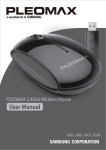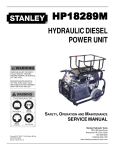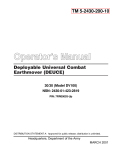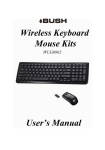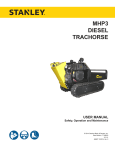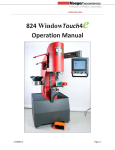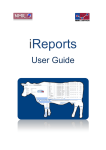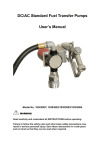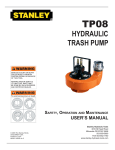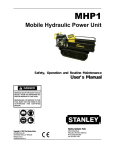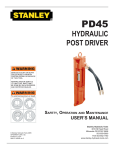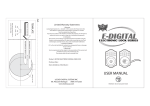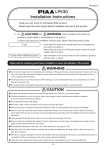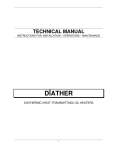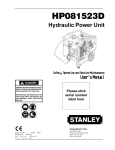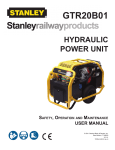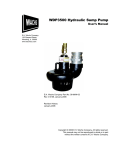Download HP10284M Diesel, Single 2
Transcript
HP18284 M Hydraulic Diesel Power Unit DRAFT MANUAL Safety, Operation and Routine Maintenance User's Manual SERIOUS INJURY OR DEATH COULD RESULT FROM THE IMPROPER REPAIR OR SERVICE OF THIS TOOL. REPAIRS AND / OR SERVICE TO THIS TOOL MUST ONLY BE DONE BY AN AUTHORIZED AND CERTIFIED DEALER. Stanley Hydraulic Tools Copyright © 2001 The Stanley Works OPS/MAINT USA & CE VERSION 43537 08/2001 Ver 2 3810 SE Naef Road Milwaukie, OR 97267-5698 USA Phone: (503) 659-5660 Fax: (503) 652-1780 CONTENTS Accessories ....................................................................................................................... 14 General Maintenance ........................................................................................................ 11 Hydraulic Hose Requirements ............................................................................................ 6 Operation ..................................................................................................................... 7 - 10 Safety Precautions ......................................................................................................... 2 - 3 Service Instructions ................................................................................................... 15 - 18 Parts Illustrations ...................................................................................... 19 - 28 Specifications .................................................................................................................... 14 Tool Stickers and Tags ................................................................................................... 4 - 5 Troubleshooting ......................................................................................................... 12 - 13 Warranty ........................................................................................................................... 30 SERVICING THE POWER UNIT: This manual contains safety, operation, and detailed maintenance instructions. Stanley Hydraulic Tools recommends that servicing of hydraulic tools, other than routine maintenance, must be performed by an authorized and certified dealer. Please read the following warning. SERIOUS INJURY OR DEATH COULD RESULT FROM THE IMPROPER REPAIR OR SERVICE OF THIS TOOL. REPAIRS AND / OR SERVICE TO THIS TOOL MUST ONLY BE DONE BY AN AUTHORIZED AND CERTIFIED DEALER. 1 SAFETY Tool operators and maintenance personnel must always comply with the safety precautions given in this manual and on the stickers and tags attached to the tool and hose. These safety precautions are given for your safety. Review them carefully before operating the tool and before performing general maintenance or repairs. Supervising personnel should develop additional precautions relating to the specific work area and local safety regulations. If so, place the added precautions in the space provided on page 3. GENERAL SAFETY PRECAUTIONS The HPR Compact Power Unit will provide safe and dependable service if operated in accordance with the instructions given in this manual. Read and understand this manual and any stickers and tags attached to the power unit and hoses before operation. Read and understand the engine manual furnished with the unit. Failure to do so could result in personal injury or equipment damage. • Operator must start in a work area without bystanders. The operator must be familiar with all prohibited work areas such as excessive slopes and dangerous terrain conditions. • Establish a training program for all operators to ensure safe operation. • Do not operate the power unit unless thoroughly trained or under the supervision of an instructor. • Always wear safety equipment such as goggles, ear, head protection, and safety shoes at all times when operating the power unit and a tool. • Do not inspect or clean the power unit while it is running. • Supply hoses and fittings must have a minimum working pressure rating of 2500 psi/175 bar. • Be sure all hose connections are tight. • Make sure all hoses are connected for correct flow direction to and from the tool being used. • Do not inspect hoses and fittings for leaks by using bare hands. "pin-hole" leaks can penetrate the skin. • Never operate the power unit in a closed space. Inhalation of engine exhaust can be fatal. • Never wear loose clothing that can get entangled in the working parts of the power unit. • Keep all parts of your body away from the working parts of the power unit. • Keep clear of hot engine exhaust. • The hydraulic circuit control valve must be in the "OFF" position when coupling or uncoupling a tool. Wipe all couplers clean before connecting. Use only lint-free cloths. Failure to do so may result in damage to the quick couplers and cause overheating of the hydraulic system. • Do not add fuel to the power unit while the power unit is running or is still hot. • Do not operate the power unit if diesel odor is present indicating a fuel leak. 2 SAFETY Continued . . . • Do not use flammable solvents around the power unit engine. • Do not operate the power unit within 3.3 ft./1 m of buildings, obstructions, or flammable objects. • Allow the engine to cool before storing the power unit in an enclosure. • Do not operate a damaged, improperly adjusted, or incompletely assembled power unit. • To avoid personal injury or equipment damage, all tool repair, maintenance and service must only be performed by authorized and properly trained personnel. SAFETY SYMBOLS Safety symbols are used to emphasize all operator, maintenance and repair actions which, if not strictly followed, could result in a life-threatening situation, bodily injury or damage to equipment. This safety symbol may appear on the tool. It is used to alert the operator of an action that could place him/her or others in a life threatening situation. This safety symbol appears in these instructions to identify an action that could cause bodily injury to the operator or other personnel. This safety symbol appears in these instructions to identify an action or condition that could result in damage to the tool or other equipment. Always observe safety symbols. They are included for your safety and for the protection of the tool. LOCAL SAFETY REGULATIONS Enter any local safety regulations here. Keep these instructions in an area accessible to the operator and maintenance personnel. 3 TOOL STICKERS & TAGS CAUTION 28044 Decal - located on dash panel 28047 Decal - located on dash panel D A N G E R D A N G E R 1. FAILURE TO USE HYDRAULIC HOSE LABELED AND CERTIFIED AS NON-CONDUCTIVE WHEN USING HYDRAULIC TOOLS ON OR NEAR ELECTRICAL LINES MAY RESULT IN DEATH OR SERIOUS INJURY. BEFORE USING HOSE LABELED AND CERTIFIED AS NON-CONDUCTIVE ON OR NEAR ELECTRIC LINES BE SURE THE HOSE IS MAINTAINED AS NON-CONDUCTIVE. THE HOSE SHOULD BE REGULARLY TESTED FOR ELECTRIC CURRENT LEAKAGE IN ACCORDANCE WITH YOUR SAFETY DEPARTMENT INSTRUCTIONS. 2. A HYDRAULIC LEAK OR BURST MAY CAUSE OIL INJECTION INTO THE BODY OR CAUSE OTHER SEVERE PERSONAL INJURY. The safety tag (p/n 15875) at right is attached to the tool when shipped from the factory. Read and understand the safety instructions listed on this tag before removal. We suggest you retain this tag and attach it to the tool when not in use. A DO NOT EXCEED SPECIFIED FLOW AND PRESSURE FOR THIS TOOL. EXCESS FLOW OR PRESSURE MAY CAUSE A LEAK OR BURST. B DO NOT EXCEED RATED WORKING PRESSURE OF HYDRAU LIC HOSE USED WITH THIS TOOL. EXCESS PRESSURE MAY CAUSE A LEAK OR BURST. C CHECK TOOL HOSE COUPLERS AND CONNECTORS DAILY FOR LEAKS. DO NOT FEEL FOR LEAKS WITH YOUR HANDS. CONTACT WITH A LEAK MAY RESULT IN SEVERE PERSONAL INJURY. D DO NOT LIFT OR CARRY TOOL BY THE HOSES. DO NOT ABUSE HOSE. DO NOT USE KINKED, TORN OR DAMAGED HOSE. 3. MAKE SURE HYDRAULIC HOSES ARE PROPERLY CONNECTED TO THE TOOL BEFORE PRESSURING SYSTEM. SYSTEM PRESSURE HOSE MUST ALWAYS BE CONNECTED TO TOOL "IN" PORT. SYSTEM RETURN HOSE MUST ALWAYS BE CONNECTED TO TOOL "OUT" PORT. REVERSING CONNECTIONS MAY CAUSE REVERSE TOOL OPERATION WHICH CAN RESULT IN SEVERE PERSONAL INJURY. 4. DO NOT CONNECT OPEN-CENTER TOOLS TO CLOSED-CENTER HYDRAULIC SYSTEMS. THIS MAY RESULT IN LOSS OF OTHER HYDRAULIC FUNCTIONS POWERED BY THE SAME SYSTEM AND/ OR SEVERE PERSONAL INJURY. 5. BYSTANDERS MAY BE INJURED IN YOUR WORK AREA. KEEP BYSTANDERS CLEAR OF YOUR WORK AREA. 6. WEAR HEARING, EYE, FOOT, HAND AND HEAD PROTECTION. 7. TO AVOID PERSONAL INJURY OR EQUIPMENT DAMAGE, ALL TOOL REPAIR MAINTENANCE AND SERVICE MUST ONLY BE PERFORMED BY AUTHORIZED AND PROPERLY TRAINED PERSONNEL. I M P O R TA N T I M P O R TA N T READ OPERATION MANUAL AND SAFETY INSTRUCTIONS FOR THIS TOOL BEFORE USING IT. READ OPERATION MANUAL AND SAFETY INSTRUCTIONS FOR THIS TOOL BEFORE USING IT. USE ONLY PARTS AND REPAIR PROCEDURES APPROVED BY STANLEY AND DESCRIBED IN THE OPERATION MANUAL. USE ONLY PARTS AND REPAIR PROCEDURES APPROVED BY STANLEY AND DESCRIBED IN THE OPERATION MANUAL. TAG TO BE REMOVED ONLY BY TOOL OPERATOR. TAG TO BE REMOVED ONLY BY TOOL OPERATOR. SEE OTHER SIDE 15875 SEE OTHER SIDE 15875 SAFETY TAG P/N 15875(shown smaller than actual size) 4 TOOL STICKERS & TAGS CONTINUED 28045 Decal - located on dash panel N/A for HP10284M 29133 Decal - located on frame below dash panel HYDRAULIC FLUID 35686 Decal - located on hydraulic tank filter block 32231 Decal - located on fuel tank REFER to HP18284M Start Procedure (Page 10) DANGER 28046 Decal - located on dash panel 35677 Decal - located on dash panel 5 HYDRAULIC HOSE REQUIREMENTS HOSE TYPES Hydraulic hose types authorized for use with Stanley Hydraulic Tools are as follows: ➊ Certified non-conductive ➋ Wire-braided (conductive) ➌ Fabric-braided (not certified or labeled non-conductive) Hose ➊ listed above is the only hose authorized for use near electrical conductors. Hoses ➋ and ➌ listed above are conductive and must neverbe used near electrical conductors. HOSE SAFETY TAGS To help ensure your safety, the following DANGER tags are attached to all hose purchased from Stanley Hydraulic Tools. DO NOT REMOVE THESE TAGS. If the information on a tag is illegible because of wear or damage, replace the tag immediately. A new tag may be obtained at no charge from your Stanley Distributor. D A N G E R D A N G E R 1 FAILURE TO USE HYDRAULIC HOSE LABELED AND CERTIFIED AS NON-CONDUCTIVE WHEN USING HYDRAULIC TOOLS ON OR NEAR ELECTRIC LINES MAYRESULT IN DEATH OR SERIOUS INJURY. FOR PROPER AND SAFE OPERATION MAKE SURE THAT YOU HAVE BEEN PROPERLY TRAINED IN CORRECT PROCEDURES REQUIRED FOR WORK ON OR AROUND ELECTRIC LINES. 3. DO NOT EXCEED HOSE WORKING PRESSURE OR ABUSE HOSE. IMPROPER USE OR HANDLING OF HOSE COULD RESULT IN BURST OR OTHER HOSE FAILURE. KEEP HOSE AS FAR AWAY AS POSSIBLE FROM BODY AND DO NOT PERMIT DIRECT CONTACT DURING USE. CONTACT AT THE BURST CAN CAUSE BODILY INJECTION AND SEVERE PERSONAL INJURY. 2. BEFORE USING HYDRAULIC HOSE LABELED AND CERTIFIED AS NON-CONDUCTIVE ON OR NEAR ELECTRIC LINES. WIPE THE ENTIRE LENGTH OF THE HOSE AND FITTING WITH A CLEAN DRY ABSORBENT CLOTH TO REMOVE DIRT AND MOSISTURE AND TEST HOSE FOR MAXIMUM ALLOWABLE CURRENT LEAKAGE IN ACCORDANCE WITH SAFETY DEPARTMENT INSTRUCTIONS. 4. HANDLE AND ROUTE HOSE CAREFULLY TO AVOID KINKING, ABRASION, CUTTING, OR CONTACT WITH HIGH TEMPERATURE SURFACES. DO NOT USE IF KINKED. DO NOT USE HOSE TO PULL OR LIFT TOOLS, POWER UNITS, ETC. 5. CHECK ENTIRE HOSE FOR CUTS CRACKS LEAKS ABRASIONS, BULGES, OR DAMAGE TO COUPLINGS IF ANY OF THESE CONDITIONS EXIST, REPLACE THE HOSE IMMEDIATELY. NEVER USE TAPE OR ANY DEVICE TO ATTEMPT TO MEND THE HOSE. DO NOT REMOVE THIS TA G DO NOT REMOVE THIS TA G The tag shown below is attached to "certified non-conductive" hose. 6. AFTER EACH USE STORE IN A CLEAN DRY AREA. SEE OTHER SIDE 3 SIDE 1 SEE OTHER SIDE (shown smaller than actual size) SIDE 2 The tag shown below is attached to "conductive" hose. DO NOT REMOVE THIS TA G 1 DO NOT USE THIS HYDRAULIC HOSE ON OR NEAR ELECTRIC LINES. THIS HOSE IS NOT LABELED OR CERTIFIED AS NON-CONDUCTIVE. USING THIS HOSE ON OR NEAR ELECTRICAL LINES MAY RESULT IN DEATH OR SERIOUS INJURY. 2. FOR PROPER AND SAFE OPERATION MAKE SURE THAT YOU HAVE BEEN PROPERLY TRAINED IN CORRECT PROCEDURES REQUIRED FOR WORK ON OR AROUND ELECTRIC LINES. 5. CHECK ENTIRE HOSE FOR CUTS CRACKS LEAKS ABRASIONS, BULGES, OR DAMAGE TO COUPLINGS IF ANY OF THESE CONDITIONS EXIST, REPLACE THE HOSE IMMEDIATELY. NEVER USE TAPE OR ANY DEVICE TO ATTEMPT TO MEND THE HOSE. 6. AFTER EACH USE STORE IN A CLEAN DRY AREA. 3. DO NOT EXCEED HOSE WORKING PRESSURE OR ABUSE HOSE. IMPROPER USE OR HANDLING OF HOSE COULD RESULT IN BURST OR OTHER HOSE FAILURE. KEEP HOSE AS FAR AWAY AS POSSIBLE FROM BODY AND DO NOT PERMIT DIRECT CONTACT DURING USE. CONTACT AT THE BURST CAN CAUSE BODILY INJECTION AND SEVERE PERSONAL INJURY. 4. HANDLE AND ROUTE HOSE CAREFULLY TO AVOID KINKING, CUTTING, OR CONTACT WITH HIGH TEMPERATURE SURFACES. DO NOT USE IF KINKED. DO NOT USE HOSE TO PULL OR LIFT TOOLS, POWER UNITS, ETC. DO NOT REMOVE THIS TA G D A N G E R D A N G E R SEE OTHER SIDE SEE OTHER SIDE SIDE 1 (shown smaller than actual size) SIDE 2 HOSE PRESSURE RATING The rated working pressure of the hydraulic hose must be equal to or higher than the relief valve setting on the hydraulic system. 6 quick disconnect fittings (NPT type threads). (See Figure 1.) CONTROL PANEL Longer hoses may be used when necessary, but can effect the operation of the engine automatic throttle due to fluid resistance in the hose. If small diameter or long hoses are used, or if restrictive fittings are connected to the supply and return ports, the pressure required to push the fluid through the system and back to the hydraulic tank will be higher. If the pressure is too high, this will cause the engine RPM to remain at full load if "AUTO" is selected on the automatic throttle. Also see "HYDRAULIC HOSE REQUIREMENTS" earlier in this manual. PRESSURE RETURN H.T.M.A. 1/2 INCH FEMALE QUICK DISCONNECT COUPLER H.T.M.A. 1/2 INCH MALE QUICK DISCONNECT COUPLER QUICK DISCONNECT COUPLERS 1/2 INCH MALE PIPE HOSE END H.T.M.A. approved quick disconnect couplings are installed to hydraulic hoses so that the direction of oil flow is always from the male to the female quick disconnect as shown in figure 1. Quick disconnect couplings and hose fittings are selected so that additional fittings such as reducer or adapter fittings are not required. 1/2 INCH I.D. HOSE, 25 FT LONG WITH 2500 PSI/ 172 BAR RATING AND 4 TO 1 SAFETY FACTOR 31848 50ft Hose & Coupler Assembly RETURN PRESSURE 1/2 INCH MALE PIPE HOSE END H.T.M.A. 1/2 INCH FEMALE QUICK DISCONNECT COUPLER H.T.M.A. 1/2 INCH MALE QUICK DISCONNECT COUPLER ADAPTER, 3/8 INCH MALE PIPE x -8 SAE O-RING PRESSURE RETURN TOOL Figure 1. Hydraulic Connections 8 If adapter fittings are used, they must be approved steel hydraulic fittings meeting a minimum operating pressure rating of 2500 psi/172 bar. Do not use galvanized pipe fittings or black pipe fittings. Use thread tape or pipe joint compound when installing quick disconnect couplings to hose or tool fittings. Follow the instructions furnished with the selected thread sealant. DO NOT OVERTIGHTEN THE FITTINGS. MAAS HOSE AND COUPLER ASSEMBLY P/N 31848 (Includes 50ft hose set and couplers) OPERATING INSTRUCTIONS PREPARATION FOR USE Use fluids meeting the following specifications. Viscosity (Fluid Thickness) ENGINE Do not operate the power unit until you have read the engine operating and maintenance instructions manual furnished in addition to this manual. U.S. METRIC 50°F 450 SSU Maximum 100°F 130-200 SSU 140°F 85 SSU Minimum 10°C 95 Centistokes 38°C 27-42 C.S. 60°C 16.5 C.S. Minimum PourPoint -10°F/-23°C Minimum (for cold startup) Vicsosity Index (ASTM D-2220) 140 Minimum Demulsibility (ASTM D-1401) 30 Minutes Maximum Flash Point (ASTM D-92) 340°F/171°C Minimum 1. Engine Crankcase Oil Level Rust Inhibition (ASTM D-665 A & B) Pass Oxidation (ASTM D-943) 1000 Hours Minimum Always check the oil level before starting tne engine. Make sure the oil level is at the FULL MARK on the dipstick. Do not overfill. Use oil as specified in the engine operating and maintenance manual. The engine oil sump must never be overfilled. Overfilling can cause the to engine to overheat and cause crankshaft seal damage. Pump Wear Test (ASTM D-2882) 60 mg Maximum The following fluids work well over a wide temperature range at starup, allow moisture to settle out and resist biological growth that may occur in cool operating hydraulic circuits. These fluids are recommended by Stanley Hydraulic Tools. Other fluids that meet or exceed the specifications of these fluids may also be used. Chevron AW-MV-32 Exxon "Univis" J-26 2. Engine Fuel Level Mobil D.T.E. 13 Check the fuel level. If low, fill with DF-1 or DF-2 diesel fuel (A.S.T.M. D975-66T No. 1 or no. 2 dark). Gulf "Harmony" AW-HVI-150-32 Shell "Tellus" T-32 Texaco "Rando" HD-AZ Shut the engine off before attempting to add fuel to the fuel tank. Do not remove the fuel cap while the engine is running. Do not add fuel to the tank while the engine is hot. Do not fill the fuel tank to a point of overflowing. Union "Unax" AW-WR-32 BATTERY The supplied 12 Volt DC battery, No maintenance dry cell The battery is air transportable and is suitable for cold weather applications. Make sure the battery cables are tight and clean HYDRAULIC FLUID Check the dipstick in the hydraulic fluid reservoir for the proper fiuid level. Proper fluid level is indicated when the center section of the dipstick shows oil. If the center section of the dipstick does not show add hydraulic fluid. Do not over fill the hydraulic tank. Oil will rise and leak from 7 the tank breather. HP1 Diesel Starting Procedures Before starting the engine make sure the hydraulic circuit control lever is in the Tool OFF position and the throttle cable is fully depressed. (FIG.2) 2. Turn the three-position switch counter clockwise until the engine begins to crank. When the engine starts release the lever. The switch nd will default to the ON (2 ) second position. (FIG.1) For cold starts, turn the starter switch to nd the ON (2 ) second position. The battery light will come on, then press and hold the glow plug for 10 to 15 seconds. Release the glow plug button and turn the start switch to the third (3rd) start position to crank the engine. Figure 1 OFF 1. 3. When the engine is warmed up, pull the throttle cable to the full open position and lock it into place. This will provide the proper RPM to obtain 8 gpm required to power the hydraulic tools. 4. Push the hydraulic tool circuit control lever right to the ON position. (Fig.2) ON Engine Shutdown Figure 2 1. Place the circuit lever in the OFF position. Push the throttle control completely in. Allow the engine to idle for approximately one minute. Pull the engine shutoff cable this stops the engine.Turn the starter switch OFF (1st) NOTE: The starter switch must be turned to the off position. Failure to do so will cause battery failure. STORAGE Oil Pressure Light A problem with the engine oil lubricating system exists if the oil pressure light remains on after the engine has started. Shutdown the engine and then have the lubricating system serviced by a qualified technician. • Clean the unit thoroughly before storage. Do not use water pressure. • Always store the unit in a clean and dry facility. • If the unit will be stored for a prolonged period (over 30 days and up to 6 months), replace the fuel filter then add diesel fuel preservative to the fuel tank. Follow the directions provided with the fuel preservative. • Check hydraulic reservoir for water. If water is found, change the oil and circulate it through the tool hose and tool. (See "HYDRAULIC SYSTEM MAINTENANCE" later in this section). • Disconnect tool hoses. COLD WEATHER STARTUP 1. Use the procedures described under "Starting The Engine" and then follow the procedures below. 2. Hydraulic fluids are thicker in cold weather, therefore, it is recommended that the engine be run at low idle long enough to bring the fluid temperature up to a minimum of 50°F/10°C or until the top of the hydraulic filter feels warm. 3. If the tools and tool hoses are cold, it is recommended to allow hydraulic fluid to circulate through the tool hoses until warm before using the tools. USING HANDLE BARS Do not lift the power unit with the handle bars extracted The power unit is equipped with retractable handle bars so it can easily be moved at the job site. 1. To use the handle bars, pull each handle bar straight out until the bar locking mechanism engages. The power unit may now be pushed about in a wheelbarrow fashion. 2. To retract the handle bar, push the latch away from the handle bar to release the lock. Then push the handle bar in. Latch Illistration N/A HP18284M Use the correct number of personel to lift or hoist the HP18284M Power Unit from the MAAS Trailer. The power unit weighs 384 lbs. Lifting the HP18284M with the handle bars extracted in the transport postion will cause damage to them. 10 GENERAL MAINTENANCE indicate air is present in the lines. Keep all suction line fittings and clamps tight. ENGINE MAINTENANCE Follow the maintenance schedule and general maintenance instructions in the engine maintenance and operation manual furnished with the power unit. Normal maintenance includes: • Hydraulic system wear is noted by increased heat during tool operation, reduced tool performance and eventual system breakdown. • Operate with the fluid temperature at 50° - 140° F/10° - 60° C for improved seal and hose life, and maximum efficiency. • Inspect the air filter daily. Clean if necessary. • Replace dry air filter every 200 hours of operation. • Replace fuel filter every 100 hours of operation. Filling The Reservoir • Change engine oil after first 50 hours of operation, then after every 200 hours of operation. Change more often if cold, moist or dusty conditions exist. 1. Make sure the engine is stopped before opening the filler cap. Fill slowly with the recommended fluid as listed in the "Operation" section of this manual. • Change oil filter when engine oil is changed. • Check oil level daily. 2. Add fluid as needed. Stop filling when the dipstick center registers inthe center. Fluid must be visible on center of the dipstick at all times. • Each day, remove dirt and debris from engine with a cloth or brush. Do not use water spray. 3. Secure the filler cap before restarting the engine. Removing Condensed Moisture From Hydraulic Fluid HYDRAULIC SYSTEM MAINTENANCE Observe the following for maximum performance and service life from the hydraulic system. • Always keep hydraulic system and fluids clean. • Keep water out of fluid. • Check hydraulic lines and fittings daily for leaks, kinks, etc. Do not use your hand to perform this check. • Make sure the suction hose (from the hydraulic tank to the inlet manifold) is clamped securely. This reduces the risk of pump cavitation. All pump fittings should be tight. • Change the hydraulic filter element every 200 hours of operation. Change more often if cold, moist or dusty conditions exist. • Check oil cooler for debris. Remove debris with air pressure. • Keep air out of hydraulic lines. Hydraulic system overheating and foam at the hydraulic tank breather 11 Condensation is a frequent problem with cool hydraulic circuits. This condition occurs in moist or cold climates. When warm air in the hydraulic tank draws moisture from the cooler air outside, water accumulates in the tank. 1. To remove water from the hydraulic system, use the "PRESSURE" hose without the quick-disconnect coupler attached. Start the engine and let it run at the idle speed. Pump the fluid into a clean 5 gal./20 ltr container. 2. Turn the engine "OFF" as soon as the hydraulic tank (reservoir) is empty. DO NOT operate the engine with an empty hydraulic tank as pump damage may occur. 3. Allow the fluid to sit long enough for the water to settle to the bottom of the container. Slowly pour the fluid back into the hydraulic tank, avoiding the water at the bottom of the container. TESTING & TROUBLESHOOTING General Tests and adjustments should be performed periodically to ensure the power unit is operating at maximum efficiency. Stanley Circuit Tester (Part Number 04182) is recommended. This tester can be used to isolate problems in both the engine and hydraulic system prior to any power unit disassembly. just begins to open is commonly referred to as the "cracking pressure". At the "cracking pressure", the flow rate should start to drop because the relief valve is allowing fluid to bypass to the hydraulic reservoir. The "cracking pressure" is preset at the factory and if it is not within the above range, the relief valve must be reset as follows: Testing The Hydraulic Circuit a. Access to the relief valves can be gained through the top of the power unit between the dash panel and top grille. If more room is required, remove the dash panel. Use a open end or box end wrench to remove the cap on the relief valve. b. Use an Allen wrench to adjust the relief valve. Turn clockwise to raise the pressure and counterclockwise to reduce the pressure. c. Replace the cap and test for 2100-2200 psi/148155 bar as described above. d. Repeat the above test with the hoses and tester connected to the other circuit. The following tests can be performed to ensure that the hydraulic pump is supplying the correct flow and pressure and that the system relief valve is operating properly. During these tests, make sure the engine is warm and operating smoothly. If test results are not as specified, refer to the troubleshooting table given in this section for possible causes. To test the Hydraulic 8gpm circuit, proceed as follows: 1. Set both Circuit Control Levers to the "OFF" (Left ) position. Push the Combiner Knob "IN" to separate the two circuits. 2. Connect the Stanley Circuit Tester across two hose ends (where the tool would normally be connected) 3. Fully open the tester restrictor valve (counter clockwise). 4. Start the engine and allow it to run until warm. 5. Pull the engine throttle control completely "OUT" so that the engine is running at full RPM. 6. Move the Circuit Control Lever for the circuit to be tested to the "ON" (up) position. 7. With the engine at high speed, the test flow gauge should read 8 gpm. 8. Slowly turn the restrictor valve clockwise while watching the pressure gauge. The flow rate should stay at 8gpm as the pressure gauge reaches 2100-2200 psi/148-155 bar. 9. At 2100-2200 psi/148-155 bar the relief valve should begin to open. The pressure at which the relief valve 12 TROUBLE SHOOTING PROBLEM Engine will not run. Fluid blowing out of fluid reservoir vent. Hydraulic tool won't operate. 13 CAUSE REMEDY Battery not connected. Attach battery cables, check wires. Weak battery. Test battery, charge or replace. No fuel. Add Fuel. Fuel filter plugged. Replace fuel filter. Defective pump seal. Replace pump seal. Hydraulic tank overfilled. Correct the fluid level. Control lever setting incorrect. Set control lever to "TOOL ON". Incorrect hose connection to tool. Make sure the tool hose goes from pressure fitting to tool and back to the return fitting. Fluid always flows from the male to female fittings. Quick disconnect fittings defective. Detach from hose, connect set together and check for free flow. Hydraulic fluid level low. Check for correct fluid level. Fill using the recommended fluid. Pump coupling defective. Check coupling between pump and blower. The coupler should slide only ..03-.06 in./.80-1.60 mm inches between blower and pump. Relief valve stuck open. Adjust or replace valve. Incorrect throttle setting Pull throttle completely out so that engine runs at full rpm. SPECIFICATIONS Flow ........................................................... O n e 8 gpm circuit Pressure Range .................................................................................................. 140 bar / 2000 psi Couplers ......................................................................................... HTMA Flush Face Type Male & Female Weight Model HP18284M............................................................................................ 152 kg / 385 lbs Overall Length Model HP18284M.............................................................................................................90cm../35.5 in Overall Width Model HP18284M ............................................................................................................ 61 cm / 24 in. Overall Height Model HP18284M With Hose Basket......................................................................... 100.33cm/ 39.5 in. Engine .............................................................................. Duetz Ruggerini MD191, 2 cylinder, diesel, 19 hp Fuel Tank Capacity ........................................................................................................... Model HP18284M............................................................................................................. 16 ltr / 4.2 gal Oil Reservoir Capacity ............................................................................................................. 11 ltr / 2.7 gal or EHTMA Category ......................... "C" (20 lpm @ 138 bar) or "D" (30 lpm @ 138 bar) ACCESSORIES P/N Description 31848 31972 24070 03974 04182 00936 02151 04192 03044 50 ft. Dual Hydraulic Hose, 1/2 in. ID, Wire Braid, with Couplers 25 ft. Dual Hydraulic Hose, 1/2 in. ID, Wire Braid, with Couplers Flush Face Coupler Set, 1/2 in. NPT NSN 4730-01-479-0555 Bruning Flush Face Coupler Set, 1/2 in. NPT Flow and Pressure Tester Adapter, 1/2 SAE to 3/8 in. Male Pipe Bushing, 1/2 in. to 3/4 in. Hex Nipple, 1/2 in. Male Pipe Hex Nipple, 3/8 in. Male Pipe MAAS TOOLS NSN Stanley # BR6713016 3820-012-421-440 HD45110D 5130-01-178-6338 PD48142 1710-01-468-8021 PP10100A 1710-01-468-8024 HP18299M 4320-01-450-3557 HP18284M 1730-01-342-2183 31848 4720-01-361-5033 Description Military Pavement Breaker Military Hammer Drill MAAS Post Driver MAAS Post Puller Hydraulic Power Unit Gasoline Powered Hydraulic Power Unit Diesil Powered 50ft. Dual hose Assembly 14 SERVICE INSTRUCTIONS GENERAL b. Service instructions in this section are limited to parts and components manufactured by Stanley Hydraulic Tools. Other major components such as the engine and hydraulic pump should be serviced by representatives of the respective manufacturers as follows: ENGINE Using the fittings or the wood dowels, plug one end of each of the short hoses. c. Duetz Ruggerini, 19 hp Model MD191 The engine should be serviced only by Ruggerini Dealers. It is recommended to contact the Deutz Corporation for the nearest authorized Ruggerini dealer at 1-770-564-7100. HYDRAULIC PUMP Four plug fittings or wood dowels to plug one end of each of the short hoses and also the ends of the hoses disconnected from the fuel tank. Thoroughly clean the exterior of the connections of the fuel supply line (16, fig 5) and the fuel return line (12, fig 5) where they are connected to the fuel tank. Disconnect one fuel line at a time, quickly plugging the fuel line and the tank port with the wood dowels or fittings and the short hose lengths to minimize spillage. Wipe up any spillage using appropriate disposal methods. Model HP18284M:The fuel tank must be removed in order to remove the engine. TBD Engine Removal a. Disconnect the hoses (13 & 14, fig 5A) and plug them with a plug fittings. b. Remove the 3 capscrews (23, fig 2A) that secure the tank to the frame. Remove the fuel tank. 4. Remove the air cleaner cover and air cleaner. Most engine servicing can be performed without removing the engine. Consult with your Ruggerini Dealer regarding engine repairs. 1. Remove both battery connections. Remove the battery strap or battery hold down. Remove the battery. 2. Remove the wheels by first removing one retaining ring, slide one washer and wheel off of the axle, then pull the other wheel and axle out of the axle brackets. Fuel Lines and Fuel Tank 3. Follow the applicable instructions below to disconnect engine fuel lines. Model HP20271: The hoses at the fuel tank must be disconnected. Obtain the following materials for plugging the fuel tank ports and the fuel hoses. a. 15 Two short lengths (2 to 3 inches) of fuel hose one with 1/4 inch inside diameter and one with 1/8 inch inside diameter. 5. Remove the top grille (8, fig 2 or 47, fig 2A). 6. Remove the fasteners that retain the cooler mounts (6 & 10, fig 1 & fig 1A) and the cooler brace (12, fig 1 and fig 1A) and remove the mounts and brace. The switch box (7, fig 1) and wiring will be loose after this procedure and can then be removed with the engine (this does not apply to model HP20271A). 7. Tie the cooler (8, fig 1 and fig 1A) to the frame rails of the frame (55, fig 2 or 39 fig 2A) so that it will not interfere with removal of the engine. 8. Disconnect the two wires leading to the hour meter. 9. Disconnect the throttle cable (6, fig 2 or fig 2A) at the engine. On model HP20271A, disconnect the stop cable (1, fig 2A) at the engine. 10. Using an Allen wrench, loosen the setscrews on the coupling assy (27 & 28, fig 2 or 16, fig 2A). 11. Unscrew and remove the nuts (37, fig 2 or 35, fig 2A) and capscrews (20, fig 1 & fig 1A) and washers. 12. Slide the engine forward being careful not to entangle the electrical wiring and not to damage other components. 13. Remove the coupling sleeve (28, fig 2 or 17, fig 2A). 14. Slide the engine, with blower housing attached, out the battery side of the frame for the HP20271 model. For the HP10284M model, slide the engine out the fuel tank side of the frame. To Reinstall Engine 1. 3. Remove the blower wheel (26, fig 1 or 24, fig 1A) with the blower hub (25, fig 1 or 1A) by loosening the set screws on the coupler flange (28, fig 1 or 1A). 4. Remove the four capscrews (14, fig 1 or 1A) holding the blower housing (16, fig 1 or 1A) to the engine. Remove the housing. Re-assembly 1. Reverse the above procedure to reinstall the above components and observe the following added procedures. a. Install capscrews which hold the blower housing to the engine using Loctite™ 242. b. Install capscrews which hold the blower wheel to the blower hub using Loctite™ 680 and torque to 80-100 lb. in. Reverse the above procedures to reinstall the engine. 2. Install the capscrews (20, fig 1 & fig 1A) so that one washer (21, fig 1 or 36 fig 1A) is installed next to the head of the capscrew, one washer is installed between the engine mounting bracket and the frame and one washer is installed between the nut (37, fig 2 or 35, fig 2A) and the frame. Tighten the capscrews and nuts to 20 ft. lb torque . 3. After installing the engine, adjust the coupling sleeve as follows: OIL COOLER 1. Remove the top grille (8, fig 2 or 47, fig 2A). 2. Remove the hoses (3 & 11, fig 5 or 5A). a. b. Move the coupling flange forward or backwards on the engine drive shaft until the drive shaft is recessed into the coupling flange bore .435 inches. Tighten the setscrews. Adjust the coupling flange on the pump until the coupling sleeve has 1/32-1/16 inch end play. 3. Remove the fasteners that retain the cooler mounts (6 & 10, fig 1 or 1A) and the cooler brace (12, fig 1 or 1A) and remove the mounts and brace. The switch box (7, fig 1) and wiring will be loose after this procedure (this does not apply to model HP20271A). 4. Lift the cooler out. BLOWER HUB, BLOWER WHEEL, INLET RING, & BLOWER HOUSING Re-assembly 1. Remove the engine as described earlier in this section. HYDRAULIC PUMP 2. To remove the blower wheel, remove the five screws (31, fig 1 or fig 1A) around the housing inlet ring (30, fig 1 or 1A) and remove the ring. 1. First remove the hydraulic fluid from the tank by either pumping it out with a portable drill pump or draining it into a container. 1. Reverse the above procedure to reinstall the cooler. 2. Remove the grille (19, fig 2 or 5, fig 2A). 3. Disconnect the pressure hoses and inlet manifold at 16 the pump. 3. Remove the 2 capscrews (21, fig 2 or 10, fig 2A) and then remove the pump. Re-assembly 1. Reverse the above procedure to reinstall the pump and observe the following step. a. Insure the coupling sleeve is installed correctly (see REINSTALL ENGINE). FUEL TANK 1. If the fuel tank contains fuel, take extreme precautions to remove the fuel into approved containers. Do not attempt to service the fuel tank in unventilated areas or in areas containing electric or natural gas appliances which may start-up unexpectantly or in shop areas where grinding or welding is present, all of which can ignite the fuel vapors. 2. Follow step 3 under "ENGINE REMOVAL" to disconnect and plug the fuel lines. To remove the tank on the model HP20271, remove the capscrews (47, fig 2) and brackets (44, fig 2) at the top of the fuel tank only. Lift the fuel tank out of the lower brackets. To remove the tank on the model HP10284M, remove 3 capscrews (23, fig 2A) and bracket 37, fig 2A). Slide the tank out. Re-assembly 1. Reverse the above procedures to reinstall the fuel tank. 3. Remove the hoses (7 & 11, fig. 5 or 5A) by loosening the hose clamps. 4. The hydraulic tank can now be removed by removing the 2 capscrews (32, fig. 2 or 23, fig 2A) and the tank support tab (29, fig. 2 or 26, fig 2A). 5. The filter can be removed from the filter head (6, fig. 4) by spinning it off counter clockwise (this does not apply to model HP10284M). 6. On model HP20271, the filter block (4, fig. 4) is removed by first removing the capscrews (2, fig. 4). Hold the grip plate in place with your fingers to prevent it from falling into the tank. For the model HP20271A, the filter assembly is removed by first removing the breather (6, fig 4A) and the dipstick bolt (12, fig 4A). Re-assembly 1. Reinstall the components and complete assembly to the frame by reversing the above procedures. DASH PANEL & VALVE ASSY 1. If it is necessary to remove the valve assembly, the battery must first be removed in order to gain access to the hose fittings and wiring located on the back of the panel. 2. After the hoses are removed, the valve assembly may be removed by first removing the capscrews (15, fig. 2 or 3, fig 2A and 27, fig. 3). Then remove the capscrews (27, fig 3) holding the valve to the dash panel. Valve Spools 1. To remove the valve spools, remove the retaining rings (14, fig. 3) and pull the valve spools out of the valve body. HYDRAULIC TANK 1. First remove the hydraulic fluid from the tank by either pumping it out with a portable drill pump or draining it into a container. 2. Remove the grille (19, fig. 2 or 5, fig 2A) by removing the 4 capscrews (9, fig. 2 or 3, fig 2A). 17 2. Inspect the finish of the valve spools and bores of the valve block. If scored or scratched, replace the part(s). Relief Valves DESCRIPTION: The relief valves allow oil to by-pass to the reservoir when the system pressure reaches a pre-set value. The relief valves are set to by-pass at a "cracking" pressure of 2100-2200 psi/148-155 bar. While adjustments can be made to the relief settings (see TESTING and TROUBLESHOOTING), the parts of the relief valves are not serviceable. Re-assembly 1. Reverse the above procedure to reinstall the above components. 18 Figure 1A Engine & Blower Parts Model HP20271A &HP18284M ITEM P/N QTY 1 ----- 1 2 3 370508 ----- 2 2 4 5 6 7 8 9 10 11 12 13 14 15 16 31241 7 03031 10 40053 1 56670 1 40078 1 ----- -40054 1 ----- -56637 1 08668 10 02474 4 02477 8 07783 1 DESCRIPTION Filter Bracket (Supplied with Item 19) Capscrew Capscrew (Supplied with Item 19) Capscrew Lock Washer Cooler Mount Fuel Filter Bracket Cooler NO ITEM Cooler Mount NO ITEM Cooler Brace Sheet Metal Screw Capscrew Washer Blower Housing ITEM P/N QTY 17 18 19 20 21 22 23 24 25 26 27 21681 4 07818 1 56641 1 14876 4 04585 22 32232 4 38878 1 56640 1 38877 1 39057 1 ----4 28 29 30 31 32 21687 08669 56643 08667 03906 1 1 1 5 2 DESCRIPTION Spacer Key Engine, Ruggerini MD191 Capscrew Washer Capscrew Spacer Blower Wheel Blower Hub QD Bushing Capscrew (Supplied with Item 26) Coupling Assy Gasket Inlet Ring Tapping Screw Locknut 20 Figure 2A Frame Parts Model HP20271A & HP18284M ITEM P/N QTY 1 2 3 4 5 6 7 8 9 10 11 12 13 14 15 56634 08080 21319 04539 56632 21715 29133 01219 56672 02116 01459 21335 27767 56659 ----- 1 2 11 15 1 1 1 4 1 2 2 1 2 1 1 16 21687 1 17 18 19 ----52754 56669 1 1 1 DESCRIPTION Stop Cable Handle Grip Capscrew Washer Grille Throttle Cable Warning Sticker Lockwasher Plug Capscrew Lock Washer Elbow Elbow Pump Key (Included with pump) Coupling Assy (Incld items 17) Part of Item 16 Hydraulic Tank Battery Hold Down ITEM 20 21 22 23 24 25 26 27 28 29 30 31 32 33 34 35 36 37 38 39 40 41 P/N QTY 04303 10499 21713 31241 04539 56671 56644 03031 04416 21319 00719 ----03906 31699 370513 04353 04585 56645 56631 56619 28089 56653 1 1 2 5 4 2 1 10 3 1 10 -4 2 4 12 22 1 1 1 1 2 DESCRIPTION Battery Battery Pad Vibration Mount Capscrew Washer Capscrew Tank Support Washer Capscrew Capscrew Locknut NO ITEM ESNA Nut Carry Handle Capscrew Locknut Washer Tank Support Axle Frame Weldment Handle Tube Wheel, Foam Filled ITEM P/N QTY 42 43 44 45 46 21318 31240 56635 56636 ----- 2 2 1 1 -- 47 48 49 50 51 52 27759 35686 04585 00147 26831 21714 1 1 2 2 2 2 DESCRIPTION Washer Retaining Ring Fuel Tank Fuel Tank Cap Supplied with Item 44 Top Grille Decal, Hyd. Fluid Washer Nut Washer Bumper 22 Figure 4 Hydraulic Tank Parts Model HP20271A & HP18284M ITEM QTY 1 1 2 3 52774 52775 43592 1 1 1 4 5 40408 40080 1 1 6 7 8 9 10 11 12 13 14 25 P/N 52754 40364 40389 40133 52782 52773 52772 04306 1 1 1 1 1 1 1 1 1 DESCRIPTION Hydraulic Tank Kit (Incld items 1-14) Lid Spring Service Kit (Incld Item 4), Lid O-ring, Filter Receptacle O-ring, Breather Element and Breather Cover) Filter Element Filter Assy (Incld Items 1-5 and 11-13) Capscrew Elbow, 45° Capscrew Tank Grip Plate Gasket Dipstick Bolt Dipstick Hose 27 Figure 5A Hoses, Fittings, and Clamps Model HP20271A & HP18284M ITEM 1 2 3 4 5 6 7 8 9 10 11 12 13 14 P/N 07821 04889 35220 35218 35217 08045 35343 11179 07747 27781 04306 56696 04317 04308 QTY 2 4 1 1 1 1 1 2 1 1 1 1 2 1 DESCRIPTION 90° Elbow Hose Clamp Hose, Cooler Supply Hose Assy Hose Assy Hose Clamp Hose, Suction Hose Clamp Sleeve, Suction Tube, Suction Hose Hose Hose Clamp Hose Figure 6 Wiring Diagram Model HP20271/ HP18284M ITEM 1 2 3 4 5 6 P/N 21815 23683 08725 21776 21775 21812 QTY 1 1 1 1 1 1 DESCRIPTION Wire Assy, Black Wire Assy, Green Wire Assy, Black Circuit Breaker Glow Plug Switch Wire Assy, White 28 Figure 6A Wiring Diagram Model HP20271A ITEM 1 2 3 29 P/N ----23683 56640 QTY -1 1 DESCRIPTION NO ITEM Wire Assy, Green Wire Assy, Black Included with HP10284M WARRANTY Stanley Hydraulic Tools (hereinafter called “Stanley”), subject to the exceptions contained below, warrants new hydraulic tools for a period of one year from the date of sale to the first retail purchaser, or for a period of 2 years from the shipping date from Stanley, whichever period expires first, to be free of defects in material and/or workmanship at the time of delivery, and will, at its option, repair or replace any tool or part of a tool, or new part, which is found upon examination by a Stanley authorized service outlet or by Stanley’s factory in Milwaukie, Oregon to be DEFECTIVE IN MATERIAL AND/OR WORKMANSHIP. EXCEPTIONS FROM WARRANTY NEW PARTS: New parts which are obtained individually are warranted, subject to the exceptions herein, to be free of defects in material and/or workmanship at the time of delivery and for a period of 6 months after the date of first usage. Seals and diaphragms are warranted to be free of defects in material and/or workmanship at the time of delivery and for a period of 6 months after the date of first usage or 2 years after the date of delivery, whichever period expires first. Warranty for new parts is limited to replacement of defective parts only. Labor is not covered. FREIGHT COSTS: Freight costs to return parts to Stanley, if requested by Stanley for the purpose of evaluating a warranty claim for warranty credit, are covered under this policy if the claimed part or parts are approved for warranty credit. Freight costs for any part or parts which are not approved for warranty credit will be the responsibility of the individual. SEALS & DIAPHRAGMS: Seals and diaphragms installed in new tools are warranted to be free of defects in material and/or workmanship for a period of 6 months after the date of first usage, or for a period of 2 years from the shipping date from Stanley, whichever period expires first. CUTTING ACCESSORIES: Cutting accessories such as breaker tool bits are warranted to be free of defects in material and or workmanship at the time of delivery only. ITEMS PRODUCED BY OTHER MANUFACTURERS: Components which are not manufactured by Stanley and are warranted by their respective manufacturers. a. Costs incurred to remove a Stanley manufactured component in order to service an item manufactured by other manufacturers. ALTERATIONS & MODIFICATIONS: Alterations or modifications to any tool or part. All obligations under this warranty shall be terminated if the new tool or part is altered or modified in any way. NORMAL WEAR: any failure or performance deficiency attributable to normal wear and tear such as tool bushings, retaining pins, wear plates, bumpers, retaining rings and plugs, rubber bushings, recoil springs, etc. INCIDENTAL/CONSEQUENTIAL DAMAGES: To the fullest extent permitted by applicable law, in no event will STANLEY be liable for any incidental, consequential or special damages and/or expenses. FREIGHT DAMAGE: Damage caused by improper storage or freight handling. LOSS TIME: Loss of operating time to the user while the tool(s) is out of service. IMPROPER OPERATION: Any failure or performance deficiency attributable to a failure to follow the guidelines and/or procedures as outlined in the tool’s operation and maintenance manual. MAINTENANCE: Any failure or performance deficiency attributable to not maintaining the tool(s) in good operating condition as outlined in the Operation and Maintenance Manual. HYDRAULIC PRESSURE & FLOW, HEAT, TYPE OF FLUID: Any failure or performance deficiency attributable to excess hydraulic pressure, excess hydraulic back-pressure, excess hydraulic flow, excessive heat, or incorrect hydraulic fluid. REPAIRS OR ALTERATIONS: Any failure or performance deficiency attributable to repairs by anyone which in Stanley’s sole judgement caused or contributed to the failure or deficiency. MIS-APPLICATION: Any failure or performance deficiency attributable to mis-application. “Mis-application” is defined as usage of products for which they were not originally intended or usage of products in such a matter which exposes them to abuse or accident, without first obtaining the written consent of Stanley. PERMISSION TO APPLY ANY PRODUCT FOR WHICH IT WAS NOT ORIGINALLY INTENDED CAN ONLY BE OBTAINED FROM STANLEY ENGINEERING. WARRANTY REGISTRATION: STANLEY ASSUMES NO LIABILITY FOR WARRANTY CLAIMS SUBMITTED FOR WHICH NO TOOL REGISTRATION IS ON RECORD. In the event a warranty claim is submitted and no tool registration is on record, no warranty credit will be issued without first receiving documentation which proves the sale of the tool or the tools’ first date of usage. The term “DOCUMENTATION” as used in this paragraph is defined as a bill of sale, or letter of intent from the first retail customer. A WARRANTY REGISTRATION FORM THAT IS NOT ALSO ON RECORD WITH STANLEY WILL NOT BE ACCEPTED AS “DOCUMENTATION”. NO ADDITIONAL WARRANTIES OR REPRESENTATIONS This limited warranty and the obligation of Stanley thereunder is in lieu of all other warranties, expressed or implied including merchantability or fitness for a particular purpose except for that provided herein. There is no other warranty. This warranty gives the purchaser specific legal rights and other rights may be available which might vary depending upon applicable law. 30






























